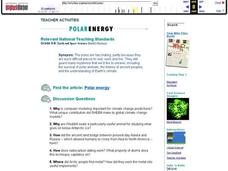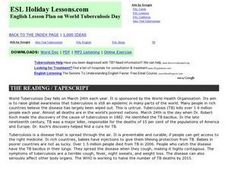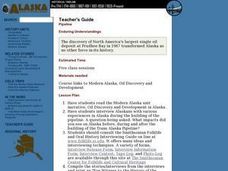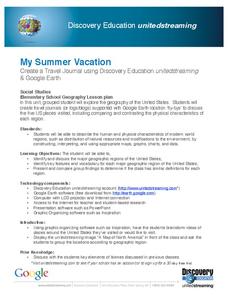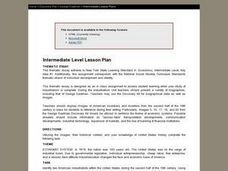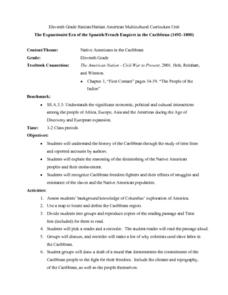Curated OER
Investigation of Immigration
Students assume the role of a crime scene detective and examine the lives of various immigrant groups. In this immigration lesson, students examine evidence, websites, and pull from existing knowledge to determine which group they are...
Curated OER
Polar Energy
Students define and read an article on polar energy. For this polar energy lesson, students answer questions about the article. Students participate in activities related to isotopes, half-life and radiocarbon. Students...
Curated OER
Yemen Cargo Bombs Foiled
Students explore an international terror alert originating in Yemen. In this instructional activity, students read an article that explains a terror alert in Britain, then complete several activities that reinforce the reading,...
Curated OER
World Tuberculosis Day
March 24th is annually recognized as World Tuberculosis Day. In this World Tuberculosis Day worksheet, students complete activities such as word scramble, numbering passages, scrambled sentences, think=pair-share, and peer interviewing....
Curated OER
The Future of the Arctic National Wildlife Refuge
Students research the governments role is preserving the Arctic National Wildlife Refuge. They discuss the proponents and the opponents side of the issue.
Curated OER
Pipeline
Students read and discuss essays about Alaska Native cultures. They discuss changes that have occurred in Alaska over the last 50 years.
Curated OER
World War II Webquest
Tenth graders work with a partner to locate and follow the directions of a webquest of their choice. Using the internet, they research their topic in depth and write a paper on their findings. They are assessed by the criteria on the...
Curated OER
Lost in Uruguay
This quiz on the culture and geography of Uruguay may serve best as a sponge activity for those who have finished an assignment. Questions are multiple-choice, and each correct answer is worth 15 points. Quiz-takers must earn 1000 points...
Curated OER
Lone Pine- Cultural Fire Management
Fourth graders investigate the concept of fire and how it was used by the Native Americans. The lesson has sufficient background information for the teacher to establish historical context. Students summarize the nine uses for fire to...
Curated OER
The Adventure Begins: "Boys I Believe I Have Found a Gold Mine!"
Students view and discuss historical documents regarding Native Americans and Californians prior to the gold rush in the 1940's. They complete a variety of activities designed to show what they have learned from these sources and class...
Curated OER
My Summer Vacation
Students study the United States geography using Google Earth. In this U.S. geography lesson, students create travel journals about five U.S. geographical locations. Students research the human and physical characteristics for each region.
Curated OER
The American Revolution
Students study the American Revolution using Google Earth and United Streaming online resources. In this American Revolution lesson, students complete a KWL chart with information they know about the American Revolution. Students then...
Curated OER
Pre-Columbian Native Peoples and Technology
Students explore Pre-Columbian native cultures. In this Exploration Era lesson, students define the words "primitive," "civilized," and "technology." Students consider the connotations of the words and then investigate...
Curated OER
Early Explorers
Students answer short answer questions and participate in a role play where they are explorers being interviewed. In this early explorers lesson plan, students discuss why it is beneficial to be the first one in a place.
Curated OER
"Julie of the Wolves"
Fifth graders research life in Alaska and compare life there to their lives in this lesson plan. They read "Julie of the Wolves." They research through the novel and other reference books facts about the Alaskan climate and geography. ...
Curated OER
Eastern Woodland Indians
Fifth graders research the Eastern Woodland Indians in this lesson. They list the tribes and write a description of the physical environment. They list examples of the types of food, clothing, transportation, home/shelter,...
Curated OER
Getting There: "Do You Want To Go To California?"
Students, in groups, participate in a variety of activities regarding the rise of Anglo-American immigration in the 1840s and its impact upon California. They discuss immigration from the West and the East as it influenced the culture of...
Curated OER
ECONOMIC SYSTEM
Students identify two American industrialists within the United States during the second half of the 19th century. They use specific examples, compare and contrast how these two industrialists were successful in their market. Students...
Curated OER
What is evolution and how does it work?
Students discuss the theory of evolution. In this evolution lesson, students discover Charles Darwin and his ideas of heredity, variation, and selection. This lesson gives information for the students to read.
Curated OER
Baltimoreans in the California Gold Rush
Eleventh graders explore the reasons for migration to California during the Gold Rush. In this American History lesson, 11th graders read letters about the opportunities and obstacles people faced. Students create a map of...
Curated OER
States And Shapes
Learners work together and investigate the shapes of 50 states. They identify the states that they find hardest to recognize. The group then list the states in order from most difficult to just difficult to recognize and create a...
Curated OER
Voyage to the New World
Students examine the exploration of the New World. They write a descriptive account of the first encounter between Europeans and Native Americans, analyze and label maps, plot Columbus's journey on a map, and write a chapter summary.
Curated OER
Native People of the Caribbean
Eleventh graders use a map and locate and define the Caribbean region and then work in groups to read the passage and timeline. The groups' reader will read the passage aloud and the recorder makes a list of why colonists used slave...
Curated OER
Continental Drift
In this continental drift instructional activity, students review the evidence that supports Wegener's hypothesis of continental drift. This instructional activity has 7 matching and 2 short answer questions.

